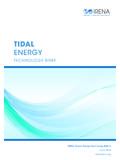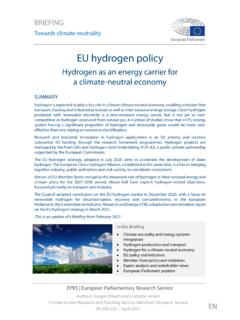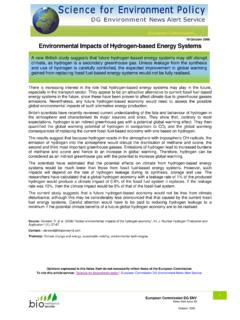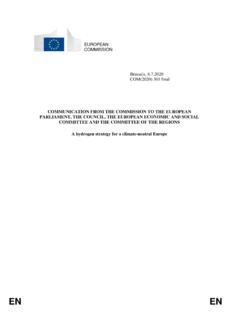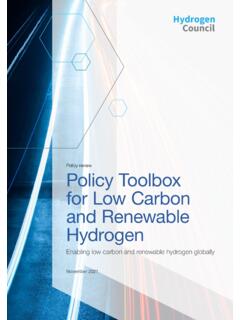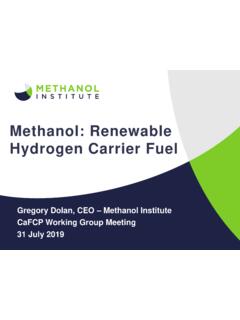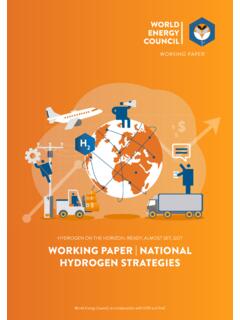Transcription of Green hydrogen: A guide to policy making
1 GREENHYDROGENA guide TO policy MAKING2 IRENA 2020 Unless otherwise stated, material in this publication may be freely used, shared, copied, reproduced, printed and/or stored, provided that appropriate acknowledgement is given of IRENA as the source and copyright holder. Material in this publication that is attributed to third parties may be subject to separate terms of use and restrictions, and appropriate permissions from these third parties may need to be secured before any use of such : IRENA (2020), Green hydrogen : A guide to policy making , International Renewable Energy Agency, Abu Dhabi ISBN.
2 978-92-9260-286-4 ABOUT IRENAThe International Renewable Energy Agency (IRENA) serves as the principal platform for international co-operation, a centre of excellence, a repository of policy , technology, resource and financial knowledge, and a driver of action on the ground to advance the transformation of the global energy system. An intergovernmental organisation established in 2011, IRENA promotes the widespread adoption and sustainable use of all forms of renewable energy, including bioenergy, geothermal, hydropower, ocean, solar and wind energy, in the pursuit of sustainable development, energy access, energy security and low-carbon economic growth and prosperity.
3 Report benefited from the reviews and comments of experts, including C dric Philibert (independent consultant), Matthias Deutsch (Agora Energiewende), Frank Wouters (EU-GCC Clean Energy Technology Network), Ruud Kempener (European Commission DG Energy), Antonello di Pardo (GSE ), Jose Miguel Bermudez and Peerapat Vithayasrichareon (IEA), Pierpaolo Cazzola and Matteo Craglia (ITF), Karl Hauptmeier (Norsk e-Fuel), Massimo Santarelli (Polytechnic University of Turin), Duncan Gibb (REN21), Thierry Lepercq (Soladvent), Hergen Thore Wolf (Sunfire GmbH), Kirsten Westphal (SWP), Ad van Wijk (TU Delft), Rina Bohle Zeller and Andrew Gordon Syme Mcintosh (Vestas).
4 IRENA colleagues Dolf Gielen, Diala Hawila, Emanuele Taibi, Paul Durrant, Raul Miranda, Barbara Jinks, Nicholas Wagner, Sufyan Diab, Jinlei Feng and Abdullah Abou Ali also provided valuable report was authored by Emanuele Bianco and Herib Blanco under the guidance of Rabia for download: further information or to provide feedback: publication and the material herein are provided as is . All reasonable precautions have been taken by IRENA to verify the reliability of the material in this publication. However, neither IRENA nor any of its officials, agents, data or other third-party content providers provides a warranty of any kind, either expressed or implied, and they accept no responsibility or liability for any consequence of use of the publication or material herein.
5 The information contained herein does not necessarily represent the views of all Members of IRENA. The mention of specific companies or certain projects or products does not imply that they are endorsed or recommended by IRENA in preference to others of a similar nature that are not mentioned. The designations employed, and the presentation of material herein, do not imply the expression of any opinion on the part of IRENA concerning the legal status of any region, country, territory, city or area or of its authorities, or concerning the delimitation of frontiers or INTRODUCTION.
6 04 ABOUT THIS guide ..051. Green hydrogen : STATUS, DRIVERS AND BARRIERS ..06 Different shades of hydrogen ..08 Drivers of the new wave of Green hydrogen ..10 Barriers to the uptake of Green hydrogen ..13 Policies to support Green hydrogen ..162. PILLARS FOR Green hydrogen policy making ..18 policy pillar 1: National strategies ..19 policy pillar 2: Establish policy priorities for Green hydrogen ..26 policy pillar 3: Guarantee of origin scheme ..29 policy pillar 4: Governance system and enabling policies ..313. SUPPORTING POLICIES FOR Green hydrogen .
7 34 policy support for electrolysis ..36 policy support for hydrogen infrastructure ..38 policy support for hydrogen in industrial applications ..40 policy support for synthetic fuels in aviation ..42 policy support for hydrogen use in maritime shipping ..444. CONCLUSIONS ..46 References ..48 Photograpghs ..50 Abbreviations and units of measure ..51 FIGURES Figure Green hydrogen production, conversion and end uses across the energy system ..07 Figure Selected shades of hydrogen ..08 Figure hydrogen production cost depending on electrolyser system cost, electricity price and operating hours.
8 14 Figure Number of hydrogen policies at a global level by segment of the value chain ..16 Figure Steps leading to the formulation of a national strategy ..20 Figure Government hydrogen -related initiatives announced between June 2018 and November 2020 ..22 Figure Main aspects and instruments mentioned in the eu hydrogen strategy ..25 Figure hydrogen as a complement to alternative ways to decarbonise end uses ..27 Figure Guarantees of origin lifecycle emissions (Illustrative) ..30 Figure Selected barriers and policies for segments of the hydrogen value chain.
9 35 TABLEST able Examples of guarantee of origin schemes ..29 BOXESBox Roles for Green hydrogen in different energy transition scenarios ..12 Box Key cost components for Green hydrogen ..14 Box hydrogen emissions from grid-powered electrolysis ..15 Box The eu hydrogen strategy ..244 INTRODUCTION The world is facing the major challenge of climate change. In 2015 the global community committed to taking action to keep global temperature rise this century well below 2 C above pre-industrial levels.
10 A growing number of countries are pledging to reach net-zero carbon dioxide (CO2) emissions by mid-century with the goal of limiting temperature rise to C. Achieving the deep or full decarbonisation of economies will require concerted and wide-ranging action across all economic sectors. We have barely begun such emission reductions. It has been estimated that less CO2 was emitted in the first six months of 2020 than in the same period in 2019, following the COVID-19 pandemic and the consequent lockdowns (Liu et al.)






